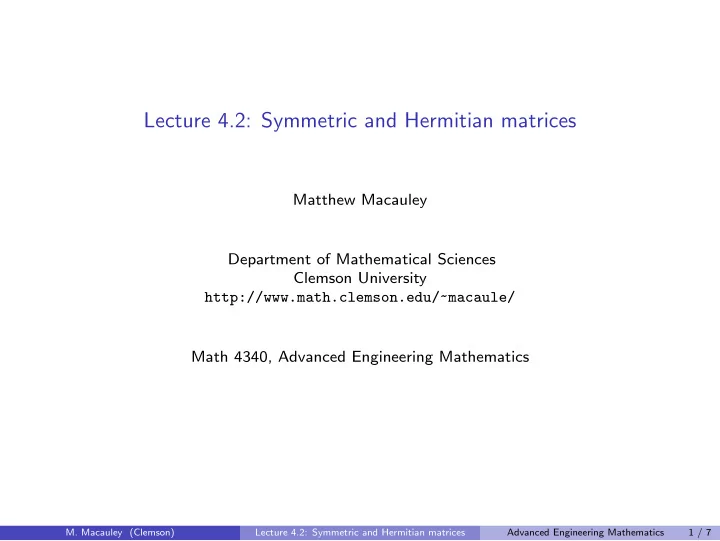

Lecture 4.2: Symmetric and Hermitian matrices Matthew Macauley Department of Mathematical Sciences Clemson University http://www.math.clemson.edu/~macaule/ Math 4340, Advanced Engineering Mathematics M. Macauley (Clemson) Lecture 4.2: Symmetric and Hermitian matrices Advanced Engineering Mathematics 1 / 7
Motivation Recall the following concept from linear algebra. Definition Let A be an n × n matrix and v ∈ R n be a vector. If Av = λ v for some λ ∈ C , then v is an eigenvector with eigenvalue λ . Remark The eigenvalues λ 1 , λ 2 of a 2 × 2 matrix A are the roots of a degree-2 polynomial. There are 3 cases: (i) distinct, real roots: −∞ < λ 1 < λ 2 < ∞ , (ii) complex roots: λ 1 , 2 = a ± bi , (iii) repeated roots: λ 1 = λ 2 . M. Macauley (Clemson) Lecture 4.2: Symmetric and Hermitian matrices Advanced Engineering Mathematics 2 / 7
Symmetric matrices Theorem If a (real-valued) matrix A is symmetric, i.e., A T = A , then: 1. All eigenvalues are real. 2. There is a full orthonormal set (a basis!) of eigenvectors. Example � 1 � 2 Compute the eigenvalues and eigenvectors of A = . 2 1 M. Macauley (Clemson) Lecture 4.2: Symmetric and Hermitian matrices Advanced Engineering Mathematics 3 / 7
Symmetric matrices Theorem If a (real-valued) matrix A is symmetric, i.e., A T = A , then 1. All eigenvalues are real. 2. There is a full orthonormal set (a basis!) of eigenvectors. Non-examples Compute the eigenvalues and eigenvectors of: � 3 � − 9 B = 4 − 3 � 1 1 � C = 0 1 M. Macauley (Clemson) Lecture 4.2: Symmetric and Hermitian matrices Advanced Engineering Mathematics 4 / 7
Hermitian matrices Theorem If a (complex-valued) matrix A is Hermitian, i.e., A T = A then 1. All eigenvalues are real. 2. There is a full orthonormal set (a basis!) of eigenvectors. Example � 0 − i � Compute the eigenvalues and eigenvectors of A = i 0 M. Macauley (Clemson) Lecture 4.2: Symmetric and Hermitian matrices Advanced Engineering Mathematics 5 / 7
Hermitian matrices Theorem If a (complex-valued) matrix A is Hermitian, i.e., A T = A then 1. All eigenvalues are real. 2. There is a full orthonormal set (a basis!) of eigenvectors. Non-example � 0 � i Compute the eigenvalues and eigenvectors of A = i 0 M. Macauley (Clemson) Lecture 4.2: Symmetric and Hermitian matrices Advanced Engineering Mathematics 6 / 7
Self-adjoint mappings Definition Let V be a vector space with inner product �− , −� . A linear map A : V → V is self-adjoint if � Av , w � = � v , Aw � , for all v , w ∈ V . Remarks Using the standard dot product in V = R n , a matrix A is self-adjoint iff it is symmetric. Using the standard inner product in V = C n , a matrix A is self-adjoint iff it is Hermitian. Theorem (proof in the next lecture) If A is self-adjoint, then: 1. All eigenvalues are real. 2. Eigenvectors corresponding to distinct eigenvalues are orthogonal. Think about what this means in (infinite-dimensional) vector spaces of functions, where differential operators are linear maps. M. Macauley (Clemson) Lecture 4.2: Symmetric and Hermitian matrices Advanced Engineering Mathematics 7 / 7
Recommend
More recommend